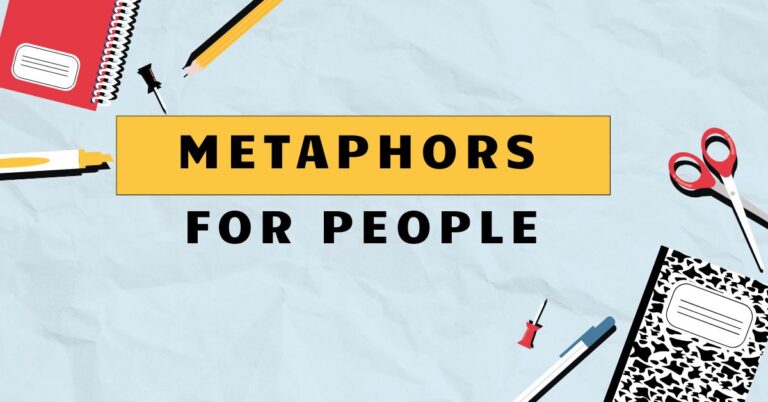49 Metaphors for Transformation: A Grammar Guide
Metaphors are powerful tools in the English language, allowing us to express abstract ideas and complex emotions in vivid and relatable ways. Understanding metaphors for transformation is crucial for grasping nuanced meanings and enhancing both writing and comprehension skills.
This guide explores how metaphors are used to describe change, growth, and evolution, benefiting students, writers, and anyone looking to deepen their understanding of English.
This article will provide a detailed exploration of transformational metaphors, covering their definition, structure, types, usage rules, and common mistakes. Through numerous examples and practice exercises, you’ll gain a solid understanding of how to effectively use metaphors to convey the concept of transformation in your own writing and speech.
Join us as we delve into the fascinating world of metaphorical language and unlock its potential to enrich your communication.
Table of Contents
- Introduction
- Definition of Metaphors for Transformation
- Structural Breakdown
- Types or Categories of Transformation
- Examples of Metaphors for Transformation
- Usage Rules
- Common Mistakes
- Practice Exercises
- Advanced Topics
- FAQ
- Conclusion
Definition of Metaphors for Transformation
Ametaphoris a figure of speech that directly compares two unrelated things, asserting that one thingisanother, not literally, but for rhetorical effect. Metaphors are used to create vivid imagery, evoke emotions, and simplify complex concepts by relating them to something more familiar.
A metaphor for transformation specifically describes a process of change, growth, or evolution.
In the context of grammar, metaphors are not grammatical structures themselves but rather lexical items (words or phrases) employed in a creative way. Understanding how metaphors function enhances our ability to interpret and construct meaningful sentences.
Metaphors rely on the principle ofimplied comparison, where the similarity between two unlike things is suggested rather than explicitly stated. A transformational metaphor, therefore, highlights the changes one subject undergoes by equating it to something that signifies change.
For example, saying “He was a caterpillar yesterday, a butterfly today” uses the caterpillar-to-butterfly transformation as a metaphor for personal growth and change. This isn’t a literal statement, but it effectively conveys the idea of a significant and positive transformation.
Understanding the function and context of metaphors for transformation is crucial for grasping the deeper meaning and intended effect of the communication.
Structural Breakdown
The structure of a metaphor for transformation typically involves two key elements: thetenorand thevehicle. The tenor is the subject being described, the thing that is undergoing transformation.
The vehicle is the object or concept to which the tenor is being compared, the thing that embodies the idea of transformation itself.
The relationship between the tenor and the vehicle is crucial. Effective metaphors create a clear and compelling connection between the two, allowing the audience to understand the transformation being described.
This connection is often based on shared qualities or characteristics that are relevant to the context of the transformation. In the example “She blossomed into a confident speaker,” the tenor is ‘she’ (the person transforming), and the vehicle is ‘blossomed’ (the act of a flower blooming, representing growth and development).
The structure can also includeground, which refers to the shared characteristics or similarities between the tenor and the vehicle. The ground provides the basis for the comparison and helps the audience understand why the metaphor is appropriate.
For example, in the metaphor “His anger melted away like ice,” the ground is the shared characteristic of being transient or disappearing. Both anger and ice are capable of dissolving or fading away.
Consider the following breakdown:
- Tenor: The subject undergoing transformation (e.g., a person, a situation, an idea).
- Vehicle: The object or concept representing the transformation (e.g., a chrysalis, a sunrise, a metamorphosis).
- Ground: The shared characteristics or similarities between the tenor and the vehicle that make the metaphor meaningful.
Understanding these structural elements allows for a more conscious and deliberate use of metaphors for transformation, leading to more effective and impactful communication.
Types or Categories of Transformation
Transformation can occur in various aspects of life and experience. Consequently, metaphors for transformation can be categorized based on the type of change they describe.
Here are some common categories:
Physical Transformation
These metaphors describe changes in physical appearance, form, or state. Examples include aging, growth, or changes in physical condition.
They often use imagery related to nature, such as plants growing or animals changing form.
Emotional Transformation
These metaphors describe changes in emotional state, such as going from sadness to happiness, or from fear to courage. They often use imagery related to weather, light, or darkness to represent emotional states.
Intellectual Transformation
These metaphors describe changes in knowledge, understanding, or perspective. They often use imagery related to learning, discovery, or enlightenment to represent intellectual growth.
Social Transformation
These metaphors describe changes in social status, relationships, or societal structures. They often use imagery related to power, influence, or social dynamics to represent these changes.
Spiritual Transformation
These metaphors describe changes in beliefs, values, or spiritual awareness. They often use imagery related to religion, mythology, or mystical experiences to represent spiritual growth.
Examples of Metaphors for Transformation
To illustrate the different categories of metaphors for transformation, here are several examples organized by type. These examples will help you understand how metaphors can be used to vividly describe various types of change.
Physical Transformation Examples
The table below provides examples of metaphors used to describe physical transformation. These metaphors often involve natural processes like growth, decay, or metamorphosis.
| Metaphor | Explanation |
|---|---|
| He morphed into a fitness guru after years of sedentary life. | Uses “morphed” to suggest a significant change in physical appearance and lifestyle. |
| She blossomed into a beautiful woman. | Compares her growth to the blossoming of a flower, signifying beauty and maturity. |
| The caterpillar transformed into a butterfly. | Classic metaphor for complete physical change and rebirth. |
| His youthful energy withered with age. | Compares the loss of energy to the withering of a plant, signifying decline. |
| The old house matured into a historical landmark. | Uses “matured” to suggest a positive transformation over time, gaining value and significance. |
| The dough rose into a fluffy loaf of bread. | Compares the dough’s increase in size to rising, indicating a change in form. |
| The city expanded like a growing organism. | Compares the city’s growth to the expansion of a living thing, indicating rapid development. |
| He hardened into a stoic figure after years of hardship. | Uses “hardened” to suggest a change in physical and emotional resilience due to difficult experiences. |
| Her skin aged like fine leather, gaining character with time. | Compares the aging process to the refinement of leather, implying beauty and value in age. |
| The river carved its way through the landscape. | Compares the river’s erosion to carving, indicating a powerful and transformative force. |
| The seed sprouted into a towering tree. | Compares the seed’s growth to sprouting, signifying the beginning of a significant transformation. |
| His muscles developed into a powerful physique. | Uses “developed” to suggest a gradual and positive physical transformation through exercise. |
| The statue emerged from the block of marble. | Compares the statue’s creation to emerging, indicating a transformation from raw material to art. |
| Her hair turned to silver with the passing years. | Uses “turned” to suggest a natural change in color, signifying aging. |
| The sculpture took shape under the artist’s hands. | Compares the sculpture’s creation to taking shape, indicating a transformation from formlessness to form. |
| His body strengthened with each workout. | Uses “strengthened” to suggest a gradual and positive physical transformation through exercise. |
| The caterpillar shed its skin as it grew. | Compares the caterpillar’s molting to shedding, signifying a necessary step in its transformation. |
| The landscape changed with the seasons. | Uses “changed” to suggest a cyclical and natural physical transformation. |
| He grew into a formidable athlete. | Compares his development to growing, indicating a significant transformation in physical ability. |
| The clay molded into a beautiful vase. | Compares the clay’s transformation to molding, signifying a change in form and purpose. |
| The ice melted into water. | Compares the ice’s change of state to melting, indicating a physical transformation due to heat. |
| His features refined with age. | Uses “refined” to suggest a positive transformation, implying elegance and sophistication. |
| The building reverted to ruins over time. | Compares the building’s decay to reverting, indicating a negative transformation back to an earlier state. |
Emotional Transformation Examples
The following table presents metaphors that describe emotional transformations. These metaphors often use imagery related to weather, light, and darkness to convey changes in feelings and mood.
| Metaphor | Explanation |
|---|---|
| Her sadness dissolved like morning mist. | Compares the fading of sadness to the dissolving of mist, signifying its impermanence. |
| He emerged from the darkness of depression. | Compares overcoming depression to emerging from darkness, indicating a positive transformation. |
| Her anger boiled over in a fit of rage. | Compares anger to boiling water, signifying a sudden and intense emotional outburst. |
| His heart froze with fear. | Compares fear to freezing, indicating a state of emotional paralysis. |
| She unfroze after years of emotional detachment. | Compares overcoming emotional detachment to unfreezing, signifying a thawing of emotions. |
| His joy erupted like a volcano. | Compares joy to a volcanic eruption, signifying a sudden and powerful outburst of happiness. |
| Her grief washed over her like a tidal wave. | Compares grief to a tidal wave, indicating an overwhelming surge of sadness. |
| He shed his inhibitions and embraced life. | Compares releasing inhibitions to shedding skin, signifying a liberation of spirit. |
| Her spirit brightened like the morning sun. | Compares the brightening of spirit to the sunrise, indicating a positive and radiant transformation. |
| His hope faded like a dying ember. | Compares the loss of hope to a dying ember, signifying a gradual decline. |
| Her despair lifted like a heavy fog. | Compares the easing of despair to the lifting of fog, indicating a sense of relief and clarity. |
| He transformed from a pessimist to an optimist. | Indicates a complete change in outlook and emotional disposition. |
| Her courage bloomed in the face of adversity. | Compares the growth of courage to the blooming of a flower, signifying strength and resilience. |
| His resentment simmered beneath the surface. | Compares resentment to simmering, indicating a suppressed and ongoing negative emotion. |
| She matured into a more compassionate person. | Uses “matured” to suggest a positive emotional transformation over time. |
| His anger subsided like a receding tide. | Compares the decrease in anger to a receding tide, signifying a gradual calming down. |
| Her fear gripped her like a vise. | Compares fear to a vise, indicating a strong and constricting emotional hold. |
| He evolved into a more understanding friend. | Uses “evolved” to suggest a gradual and positive emotional transformation. |
| Her joy sparkled like sunlight on water. | Compares joy to sparkling sunlight, indicating a bright and vibrant emotion. |
| His sadness engulfed him like a dark cloud. | Compares sadness to a dark cloud, indicating an overwhelming and oppressive emotion. |
Intellectual Transformation Examples
The following table provides examples of metaphors used to describe intellectual transformations. These metaphors often involve imagery related to enlightenment, discovery, and learning.
| Metaphor | Explanation |
|---|---|
| He awakened to the possibilities of a new career. | Compares gaining awareness to awakening, signifying a realization of potential. |
| Her mind expanded with new knowledge. | Compares intellectual growth to expansion, indicating an increase in understanding. |
| He unlocked the secrets of the ancient text. | Compares understanding to unlocking, signifying the revealing of hidden knowledge. |
| She illuminated the complex issue with her research. | Compares clarifying an issue to illumination, indicating a bringing of light and understanding. |
| His ideas crystallized into a coherent theory. | Compares the formation of ideas to crystallization, signifying clarity and structure. |
| He absorbed the information like a sponge. | Compares learning to absorption, indicating a thorough and rapid assimilation of knowledge. |
| Her understanding deepened over time. | Compares intellectual growth to deepening, signifying a greater level of comprehension. |
| He outgrew his old beliefs. | Compares changing beliefs to outgrowing clothes, signifying a shift to a new perspective. |
| Her perspective shifted after the lecture. | Compares a change in perspective to shifting, indicating a new way of seeing things. |
| He digested the complex concepts slowly. | Compares understanding concepts to digestion, signifying a gradual and thorough assimilation. |
| Her mind opened to new possibilities. | Compares gaining awareness to opening, signifying a willingness to consider new ideas. |
| He evolved into a critical thinker. | Uses “evolved” to suggest a gradual and positive intellectual transformation. |
| Her knowledge blossomed into expertise. | Compares the growth of knowledge to the blooming of a flower, signifying mastery. |
| His ignorance dissipated with education. | Compares the fading of ignorance to dissipation, indicating a reduction in lack of knowledge. |
| She transformed her confusion into clarity. | Indicates a complete change from a state of confusion to understanding. |
| His understanding dawned on him suddenly. | Compares gaining understanding to the dawn, signifying a sudden realization. |
| Her ideas took root and flourished. | Compares the establishment of ideas to taking root, signifying growth and development. |
| He molted his old assumptions. | Compares changing assumptions to molting, signifying the shedding of outdated beliefs. |
| Her insights sparkled with brilliance. | Compares insights to sparkling, indicating clarity and exceptional quality. |
| His knowledge grew exponentially. | Compares the increase in knowledge to exponential growth, signifying rapid expansion. |
Social Transformation Examples
The following table provides examples of metaphors used to describe social transformations. These metaphors often involve imagery related to power, influence, and social dynamics.
| Metaphor | Explanation |
|---|---|
| He climbed the corporate ladder. | Compares career advancement to climbing, signifying effort and progress. |
| She broke the glass ceiling. | Compares overcoming barriers to breaking glass, signifying a significant achievement. |
| The movement gained momentum. | Compares increasing support to gaining momentum, signifying growing influence. |
| He rose to prominence in the community. | Compares achieving recognition to rising, signifying an increase in status. |
| She transformed the company culture. | Indicates a complete change in the values and norms of the organization. |
| The revolution swept across the nation. | Compares the spread of a revolution to sweeping, signifying widespread and rapid change. |
| He shed his old identity and embraced a new role. | Compares changing identity to shedding skin, signifying a complete change in persona. |
| Her influence spread like wildfire. | Compares increasing influence to spreading wildfire, signifying rapid and pervasive impact. |
| He outgrew his small-town mentality. | Compares changing mindset to outgrowing clothes, signifying a shift to a broader perspective. |
| The community blossomed with new leadership. | Compares positive development to blooming, signifying growth and prosperity. |
| He reinvented himself after the scandal. | Compares changing identity to reinventing, signifying a deliberate and significant transformation. |
| Her career took off after the promotion. | Compares career advancement to taking off, signifying a rapid and successful ascent. |
| He transformed from an outsider to an insider. | Indicates a complete change in social status and acceptance. |
| The company evolved into a global leader. | Uses “evolved” to suggest a gradual and positive social transformation. |
| Her ideas took root in the organization. | Compares the establishment of ideas to taking root, signifying acceptance and influence. |
| He withered under the pressure of public scrutiny. | Compares declining performance to withering, signifying a negative impact from external forces. |
| She rose through the ranks quickly. | Compares career advancement to rising, signifying rapid progress. |
| The movement gathered steam. | Compares increasing support to gathering steam, signifying growing momentum. |
| He remodeled his public image. | Compares changing public image to remodeling, signifying a deliberate and strategic transformation. |
| Her influence permeated every level of the organization. | Compares increasing influence to permeating, signifying widespread and pervasive impact. |
Spiritual Transformation Examples
The following table presents metaphors that describe spiritual transformations. These metaphors often involve imagery related to enlightenment, faith, and inner peace.
| Metaphor | Explanation |
|---|---|
| He found enlightenment after years of searching. | Compares spiritual discovery to finding, signifying a realization of truth. |
| She shed her doubts and embraced faith. | Compares releasing doubts to shedding skin, signifying a liberation of spirit. |
| His soul awakened to a higher purpose. | Compares spiritual realization to awakening, signifying a new understanding of life’s meaning. |
| She transformed her suffering into compassion. | Indicates a complete change from a state of pain to empathy. |
| His spirit soared to new heights. | Compares spiritual growth to soaring, signifying a sense of freedom and transcendence. |
| He emerged from the darkness of despair. | Compares overcoming despair to emerging from darkness, signifying a positive spiritual transformation. |
| Her faith bloomed in the face of adversity. | Compares the growth of faith to the blooming of a flower, signifying strength and resilience. |
| He unlocked the secrets of his inner self. | Compares understanding oneself to unlocking, signifying the revealing of hidden truths. |
| Her spirit brightened like a guiding star. | Compares the brightening of spirit to a guiding star, indicating hope and direction. |
| He transformed from a skeptic to a believer. | Indicates a complete change in belief system. |
| Her soul expanded with love and forgiveness. | Compares spiritual growth to expansion, indicating an increase in compassion. |
| He shed his ego and embraced humility. | Compares releasing ego to shedding skin, signifying a liberation from pride. |
| Her inner peace grew stronger over time. | Compares the increase in inner peace to growing, signifying a gradual and positive transformation. |
| He found solace in his spiritual practice. | Compares finding comfort to finding, signifying a discovery of inner peace. |
| Her spirit soared above the challenges of life. | Compares spiritual resilience to soaring, signifying a transcendence of difficulties. |
| He transformed his anger into understanding. | Indicates a complete change from a state of negativity to empathy. |
| Her faith illuminated her path forward. | Compares faith providing guidance to illumination, signifying a bringing of light and clarity. |
| He matured spiritually through meditation. | Uses “matured” to suggest a positive spiritual transformation through practice. |
| Her soul awakened to the interconnectedness of all things. | Compares spiritual realization to awakening, signifying a new understanding of unity. |
| He transformed his fear into courage through faith. | Indicates a complete change from a state of apprehension to bravery. |
Usage Rules
When using metaphors for transformation, there are several rules to keep in mind to ensure clarity and effectiveness. Firstly, thecomparisonbetween the tenor and the vehicle should be clear and relevant.
A weak or obscure connection can confuse the audience and diminish the impact of the metaphor. The metaphor should enhance understanding, not hinder it.
Secondly,consistencyis crucial. Avoid mixing metaphors that create conflicting or nonsensical images.
For example, “He nipped that project in the bud only to see it fly” combines the idea of stopping something early with the idea of something taking flight, creating a confusing image. Stick to a consistent theme or image to maintain clarity.
Thirdly,originalitycan make your writing more engaging. While some metaphors have become clichéd through overuse, a fresh and creative comparison can capture the reader’s attention and create a more lasting impression.
Strive to find unique ways to describe transformation that resonate with your audience.
Finally,contextis important. Consider the audience and the purpose of your communication when choosing a metaphor.
A metaphor that is appropriate in one context may be unsuitable in another. Ensure that the metaphor aligns with the overall tone and message of your writing or speech.
Common Mistakes
One common mistake is using mixed metaphors, which combine two or more unrelated metaphors into a single expression, often resulting in a confusing or nonsensical image. For example:
- Incorrect: “He was skating on thin ice while climbing the ladder of success.” (Combines the ideas of risk and advancement in a confusing way.)
- Correct: “He was skating on thin ice.” (Focuses on the idea of risk.)
- Correct: “He was climbing the ladder of success.” (Focuses on the idea of advancement.)
Another mistake is usingclichéd metaphors, which are overused and have lost their impact. While cliches can be convenient, they often lack originality and fail to engage the reader.
For example:
- Clichéd: “He was a diamond in the rough.”
- Better: “His potential was hidden beneath a rough exterior, waiting to be discovered.”
A third mistake is using metaphors that aretoo abstract or obscure. If the connection between the tenor and the vehicle is not clear, the metaphor will fail to communicate effectively.
For example:
- Unclear: “His transformation was a fractal of the infinite.”
- Clearer: “His transformation was a complex and multifaceted journey, revealing new layers of understanding at every turn.”
Another error is using metaphors that areinconsistent with the context. The metaphor should align with the overall tone and message of the communication.
For example:
- Inconsistent: “The funeral was a real party.” (Inappropriate use of “party” in a somber context.)
- Correct: “The funeral was a solemn occasion.”
By avoiding these common mistakes, you can use metaphors for transformation more effectively and enhance the impact of your writing and speech.
Practice Exercises
Test your understanding of metaphors for transformation with the following exercises. Identify the type of transformation described in each sentence and explain the metaphor used.
- The caterpillar transformed into a butterfly.
- Her sadness dissolved like morning mist.
- He awakened to the possibilities of a new career.
- She broke the glass ceiling.
- His soul awakened to a higher purpose.
- The old house matured into a historical landmark.
- His anger boiled over in a fit of rage.
- Her mind expanded with new knowledge.
- The movement gained momentum.
- His spirit soared to new heights.
Answer Key:
- Physical Transformation: The caterpillar’s change to a butterfly represents a complete physical change and rebirth.
- Emotional Transformation: Her sadness fading like morning mist signifies its impermanence and gentle disappearance.
- Intellectual Transformation: He realized the potential of a new path in his professional life.
- Social Transformation: She overcame barriers to advancement, achieving a significant milestone.
- Spiritual Transformation: He had a spiritual realization, understanding the meaning of life.
- Physical Transformation: The aging of the house, becoming a landmark, represents a positive change over time.
- Emotional Transformation: His anger suddenly and intensely erupted.
- Intellectual Transformation: She gained new knowledge and understanding.
- Social Transformation: The movement’s growing influence increased its power.
- Spiritual Transformation: He felt free of earthly constraints.
Exercise 2: Rewrite the sentences below using metaphors for transformation.
- He became more confident after taking the public speaking course.
- Her knowledge increased after reading many books.
- The company grew significantly after launching the new product.
- He changed his beliefs after having a spiritual experience.
- She improved her physical fitness after starting a new exercise program.
- The relationship became stronger after overcoming many challenges.
- His understanding of the situation improved after gathering more information.
- The team’s performance improved after implementing new strategies.
- Her emotional state improved after seeking therapy.
- The community developed after receiving new funding.
Answer Key:
- He blossomed into a confident speaker after taking the public speaking course.
- Her mind expanded with knowledge after devouring countless books.
- The company skyrocketed after launching the new product.
- His old beliefs melted away after having a spiritual awakening.
- She morphed into a fitness enthusiast after starting a new exercise program.
- The relationship fortified, becoming a fortress after weathering many storms.
- His understanding of the situation crystallized after gathering more information.
- The team’s performance soared after implementing new strategies.
- Her emotional landscape cleared after seeking therapy.
- The community flourished after receiving new funding.
Advanced Topics
For advanced learners, exploring the nuances of extended metaphors and allegories can provide a deeper understanding of how transformation is conveyed through language. Anextended metaphoris a metaphor that is sustained over several lines or paragraphs, developing the comparison in more detail.
This allows for a more complex and nuanced portrayal of transformation. For example, a poem might use the metaphor of a river’s journey from its source to the sea to represent the transformation of a person’s life.
Anallegoryis a narrative in which characters and events represent abstract ideas or moral qualities. Allegories often use metaphors for transformation to convey deeper meanings about the human condition.
For example,Pilgrim’s Progressby John Bunyan is an allegory of the Christian journey to salvation, using the metaphor of a physical journey to represent spiritual transformation.
Another advanced topic is the use ofarchetypal metaphors, which are metaphors that draw on universal symbols and patterns of human experience. These metaphors often resonate deeply with audiences because they tap into shared cultural and psychological understandings of transformation.
Examples include the hero’s journey, the cycle of death and rebirth, and the quest for enlightenment.
Finally, exploring the use of metaphors for transformation in different genres and cultural contexts can provide valuable insights into how different societies and traditions understand and represent change. For example, metaphors for transformation in mythology often involve gods and goddesses undergoing metamorphosis, while metaphors in scientific writing might focus on the evolution of species or the transformation of energy.
FAQ
-
What is the difference between a metaphor and a simile?
Both metaphors and similes are figures of speech that compare two unlike things. However, a metaphor directly states that one thing is another, while a simile uses “like” or “as” to make the comparison. For example, “He is a lion” (metaphor) versus “He is like a lion” (simile).
-
How can I identify a metaphor in a sentence?
Look for statements that are not literally true but are used to create a comparison. If a sentence implies that one thing is something else without using “like” or “as,”
is likely a metaphor.
-
Why are metaphors important in writing?
Metaphors add depth, imagery, and emotional resonance to writing. They can make complex ideas more accessible and engaging for the reader.
-
Can a metaphor be a cliché?
Yes, if a metaphor is overused and has lost its original impact, it becomes a cliché. It’s best to avoid clichés and strive for fresh, original comparisons.
-
How do I create effective metaphors?
Think about the qualities or characteristics you want to convey and find an object or concept that shares those qualities. Make sure the comparison is clear, relevant, and original.
Conclusion
Metaphors for transformation are powerful tools for expressing change, growth, and evolution in vivid and relatable ways. By understanding the structure, types, and usage rules of these metaphors, you can enhance your writing and communication skills.
Avoid common mistakes like mixed metaphors and clichés, and strive for originality and clarity in your comparisons. Whether you’re describing physical, emotional, intellectual, social, or spiritual transformations, metaphors can add depth and resonance to your message.
Continue to practice and explore the creative possibilities of metaphorical language to unlock its full potential.







